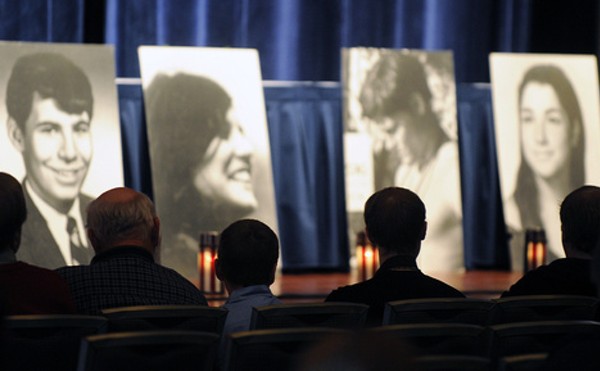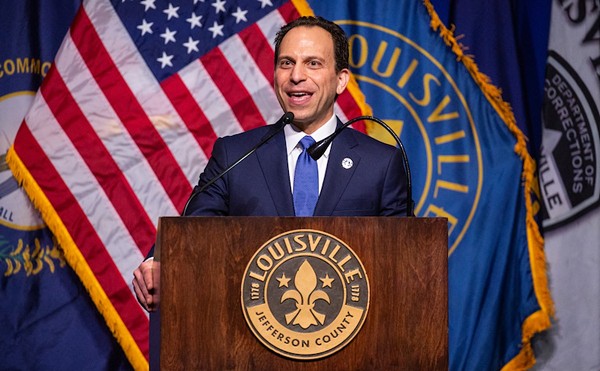
Almost always, behind the face is a fanciful and colorful landscape full of foliage. The characters’ expressions, however, may well impel the viewer to ask what lurks beyond the frame.
In January and February, this face will loom even larger over Louisville when the Speed Art Museum mounts images by Argentinean artist Flavia Da Rin on 10 14-by-48-foot billboards throughout the Metro. The Speed commissioned the 29-year-old artist behind these quasi self-portraits to create specific work for this city after Julien Robson, the museum’s curator of contemporary art, and its New Collectors Group visited Da Rin’s studio in Argentina last October. (A few group members bought art by Da Rin then. Others later bought pieces from the dpm Gallery in Miami.)
But where this large art will be, Speed staff isn’t saying. The art museum wants the exhibition to be part of an extravagant scavenger hunt. What Robson will say is that this is a concerted effort to engage the public with contemporary art. Robson also wants this exhibition to help the community see itself in new ways, with prodding from Da Rin’s images, while simultaneously reaching what he calls the “digital natives” who travel the local byways and highways. That is a term for people who have grown up with digital technology — they use cell phones frequently, they text message and they have created communities in the digital world.
“I know that this is a generation that doesn’t necessarily come to a museum — unless they are dragged there by their school,” Robson quips.
The project began in January when the museum began talking to CBS Outdoor, which owns about 400 large billboards in the Metro. The company agreed to donate 10 billboards for the project.
In planning the exhibit, Speed personnel also consulted with Web designers and marketing specialists, including Alan Moore. No, not the famed British graphic novelist (“V for Vendetta”), but the CEO of the London-based marketing company SMLXLarge and co-author of the 2005 book “Communities Dominate Brands: Business and marketing challenges for the 21st century.” Moore, who visited Louisville and met with Speed staff in March, has advised companies, including Nokia and the Coca-Cola Co., on transforming their marketing from old commercial media to engaging the public through new media.
The Speed’s ultimate goal is to encourage more public connection with contemporary art. The potential tactics include not only the use of billboards, but also the Internet, mobile phones and a curated space on a Web site. While Da Rin’s large photos are up, viewers will be able to express opinions about them and the concepts they convey via Web logs on a dedicated Web site.
Since July, Speed staff have worked on that part of the project with Micah Zender, who runs Zender + Associates in Cincinnati and designed the digital brochure for the museum’s 2002-03 exhibit “Millet to Matisse.”
“We want to score high,” Zender says of his firm’s ambition to elicit public comment about the billboards. The firm is now working on a special Web site that will let people post comments and even their own art in response to the exhibition.

Ultimately, the Speed wants to include another aspect in this project: It would like to secure 10 telephone numbers — one to be listed on each billboard — that the public can call to receive a text message with a code for special access to the Web site. The museum staff members are now discussing this idea with technology experts and cell phone carriers to see if it is viable.
Speed staff declined to discuss the cost of the project or the commissioned works. But Lonna Versluys, manager of public information, did name the New Art Collectors, SMLXLarge, Zender + Associates and CBS Outdoor as contributors to the project.
Although the Da Rin project isn’t the first time the Speed has ventured outside its walls, it is the most ambitious public project in recent years. In late 2000, the museum mounted “Beyond the Walls,” a billboard exhibition that took over traditional advertising space at bus shelters and on TARC buses. It included works by Claudia Hart, Bryce Hudson, Elizabeth Mesa-Gaido and couple Markus Muntean and Adi Rosenblum. In 2004, it installed “1000 Families” at the museum and at Waterfront Park; that exhibit featured Uwe Ommer’s life-size photographs of families from around the world.
Meanwhile, Da Rin is creating the images that will go up based, in part, on a visit she made to Louisville in September. While here, she toured the city with Robson and Louisville artist Cynthia Norton (who, like Da Rin, is a fan of the Argentinean rock band Babasónicos). They saw the Galt House, went to Churchill Downs, visited Seneca Park, lunched at Vietnam Kitchen, explored Rubbertown (where Norton’s grandfather worked), discussed history at the site of the old Fontaine Ferry amusement park, and walked around the Falls of the Ohio State Park in Clarksville.
Ultimately, Robson hopes the kind of dialogue that happened that day between artists, one from here and one from another country, can expand to encompass more people, even entire communities, all in the exploration of this community and the world through contemporary art.
To read more about the Speed exhibit, go to www.speedmuseum.org. To read a full interview with artist Flavia Da Rin, go to www.leoweekly.com. Contact the writer at [email protected]





